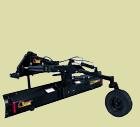Jimmy Joe
Gold Member
I have a seven foot Bush Hog, it is built pretty sturdy. One of the things I really like the off set for is in the spring when the snow is melting I can pull the snow banks back onto the road from the lawn. Most of the gravel the plow pushed on comes with it, saves a lot of raking.


